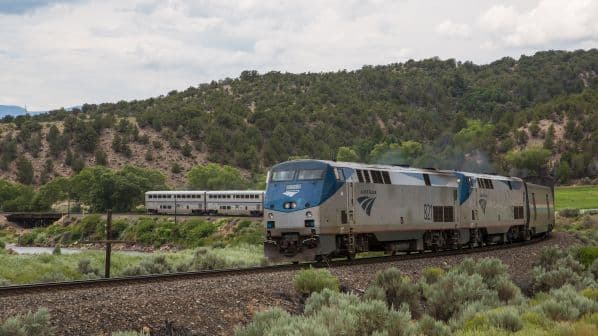IF there is one word that stands out in my interview with Mr Stephen Gardner, CEO of Amtrak in the September issue of IRJ, it is unprecedented.
Unprecedented political support for passenger rail.
Unprecedented investment and opportunities to build iconic passenger rail infrastructure.
And unprecedented public backing for plans to grow Amtrak’s service levels, to provide more trains to more communities throughout the continental United States.
So, are we on the verge of a new golden era for the passenger train in the US?
It is too early to tell. After all, many of Amtrak’s currently proposed projects and service expansions are still years away from coming to fruition. Critically, despite the huge windfall from the Biden administration’s Infrastructure Bill, they will still require a lot more cash. Bumps in the road are therefore still likely, especially if the next occupant of the White House is from the other side of the political aisle.
But Amtrak has bold plans. And arguably for the first time since it came into being on May 1 1971, the federally-owned passenger operator now has the funding to deliver at least some of its stated ambitions, and in particular that to double pre-pandemic ridership by 2040.
Amtrak believes the majority of its ridership growth will come from outside the Northeast Corridor (NEC) on routes of 1200km or less. It is executing an ambitious fleet replacement programme to help grow patronage on its existing services. An upcoming tender for long-distance coach replacement, which is expected by the end of the year or in early 2024, is described as the largest passenger fleet order in America since the 1940s. Amtrak has also added an additional 10 push-pull trains to its already vast order for a mixed fleet of 73 new sets from Siemens last month. The first of these trains are expected to enter service in 2026.
While fleet replacement is largely within Amtrak’s own hands, service expansion is more complicated.
The Federal Railroad Administration (FRA) is around halfway through a study of what a future long-distance passenger network might look like in the US. It considers Amtrak’s existing network and the potential demand for restoring passenger service on other routes as well as introducing new trains between cities without any passenger rail service at present. The study will also identify the capital projects and, critically, the funding needed to implement that vision.
The reality for the freight railways is that they are under pressure to carry more and more freight on networks that are increasingly being rationalised to deliver greater efficiency.
To deliver a truly inter-city network and deliver the growth in journeys of 1200km or less that Amtrak is targeting, a major shake-up of its current network is required. The nature of the long-distance routes that are the backbone of Amtrak’s transcontinental offer mean that many cities where there is reasonable potential demand are served at unsociable hours. The New York - Chicago Cardinal between Cincinnati, Ohio, and Indianapolis, Indiana, the only Amtrak train to serve these two major midwestern cities, leaves Cincinnati at 01.41 and arrives in Indianapolis at 05.15 on the three days a week that it runs.
To overcome these shortcomings, Amtrak would then have to have introduce more trains running shorter distances. This would increase the pressure on its host freight railways to accommodate these trains on their infrastructure.
The freight railways are legally obliged to do this. Yet the poor reliability of Amtrak’s long-distance network reflects the practical difficulties of operating passenger trains on a network dedicated to freight. The near decade-long legal struggle over the reintroduction of a twice daily passenger service between New Orleans, Louisiana, and Mobile, Alabama, also shows that when a development does not suit the Class 1s, they will endeavour to block it.
Amtrak ultimately succeeded in this case. But whether this becomes a wider precedent remains to be seen.
Gardner wants to build relationships with the new cohort of executives leading the Class 1s. He hopes to identify opportunities to enhance the network that will support both freight and passenger service growth ambitions. “I think there are a lot of places… where there’s old infrastructure and there’s a reliability problem for both passenger and freight that we should be focused on resolving,” he says.
The reality for the freight railways is that they are under pressure to carry more and more freight on networks that they are increasingly being rationalised to deliver greater efficiency. The length of the US network is only around 51% of what it was in 1978 while gross tonnage per km has increased by a factor of three during the same period. Making room for less profitable passenger trains, which reportedly pay $US 5-10 per train-mile compared with the 2021 average of $US 196 per train-mile for freight, is not a priority for the freight railways. Equally, their priorities for capital investment may not wholly align with Amtrak’s.
As Mr Lou Thompson, a long-time US rail analyst, who was among the team at the US Department of Transportation that created Amtrak, argued in a recent submission to our sister publication Railway Age, any proposal to run high-quality passenger services over freight lines must be accompanied with significant funding to buy the added infrastructure capacity and support from the freight railways. “If there ever is any actual effort to reduce carbon emissions, would this be the best way to spend our money?” he asks.
The Infrastructure Bill is an important moment. But for the true renaissance of passenger rail in the United States to materialise, it must be the first step in a sustained period of consistent government financial support for rail infrastructure expansion in America. There is little in the 50-year history of Amtrak to show that the federal government and states will have such an appetite over the long term. Unfortunately, this is likely to leave Amtrak with a whole fleet of shiny new trains, but without the network they deserve.

